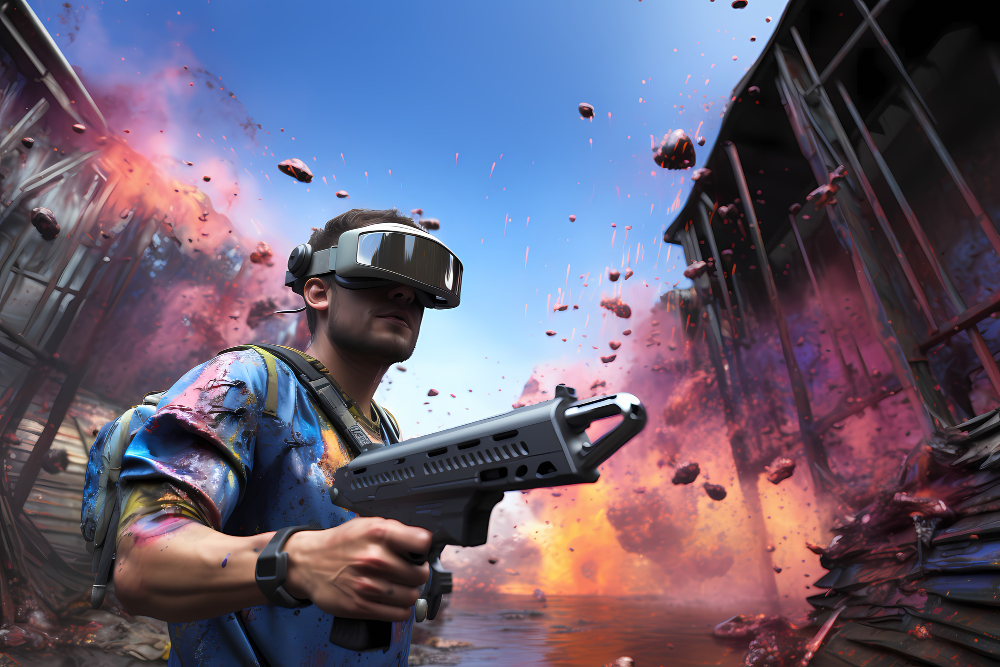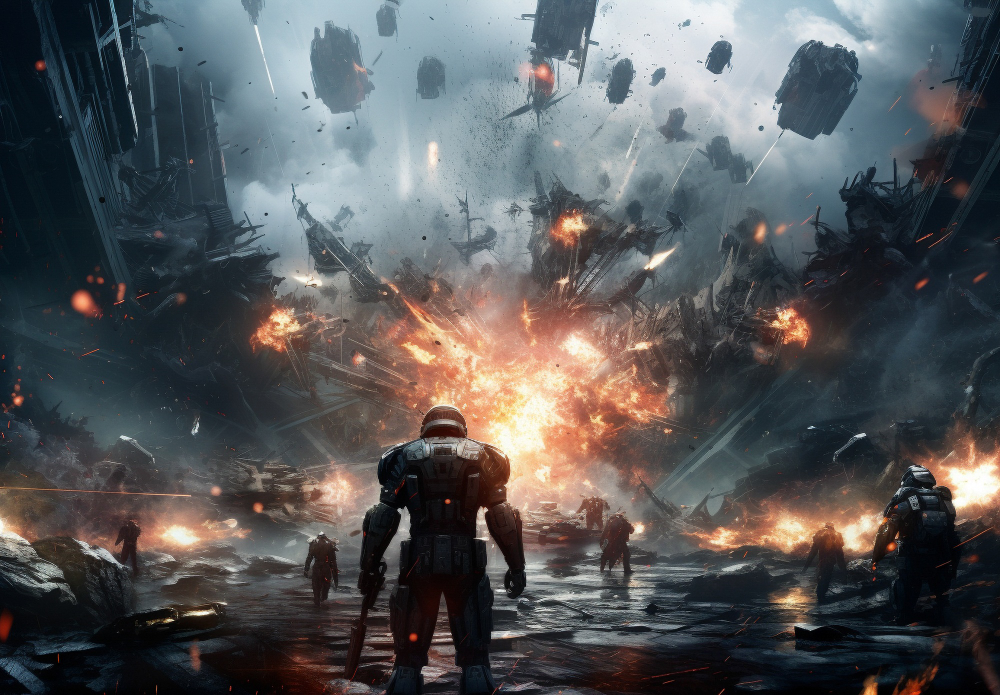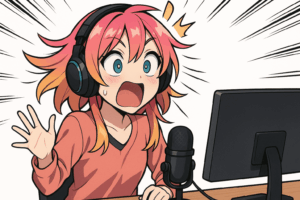When we talk about 3d models, two terms stands out – High and Low Poly. These terms not only define the intricacy but also play a crucial role in various fields. This blog will be a complete guide expalining the definition and significance, uncovering their impact on the world of 3D modeling.
Explaination of High Poly and Low Poly
High and Low Poly are terms that refer to the complexity of models based on their polygon count. High Poly models are characterized by a large number of polygons, resulting in intricate and detailed representations. On the other hand, the term Low Poly models feature a limited number of polygons, leading to simplified and detailed model.
Evolution from the Past to Present Technological Advancements
The evolution of High and Low Poly modeling techniques can be traced back to the early days of computer graphics. In the early days, technological limitations restricted the complexity of models, leading to the widespread use of Low Poly techniques. However, advancements in hardware and software have pushed the boundaries of 3D modeling, allowing for the creation of highly detailed High Poly models. Today, both techniques coexist, each serving distinct purposes in the ever-evolving landscape of 3D graphics.
Understanding Low Poly Models
Low Poly models are defined by their simplified geometry, achieved through a low polygon count. These models often feature flat surfaces and geometric shapes, giving them a distinct aesthetic appeal. The simplicity of Low Poly designs allows for efficient rendering and optimization, making them ideal for real-time applications such as low poly games and interactive media.
Aesthetics in Modern Low Poly Art
Modern Low Poly art has gained popularity for its minimalist yet visually striking style. Artists often utilize vibrant colors and bold shapes to create captivating compositions. The clean and stylized look of Low Poly art has found applications in various creative fields, including illustration, graphic design, and digital animation.
Application in Game Design and Indie Games
Low Poly models play a crucial role in the world of game design, particularly for indie developers working with final mesh. The simplicity of Low Poly style allows for smoother performance and faster loading times, making them well-suited for mobile games and low poly count projects. Additionally, the stylized aesthetic of Low Poly art can help developers achieve a unique visual identity for their games.
Optimization Techniques for Limited Resources
Simplifying Complex Shapes:
- One technique for optimizing Low Poly models involves simplifying complex shapes, with fewer polygons while maintaining overall form.
- By breaking down intricate details into simpler geometric elements, game developers can achieve significant reductions in polygon count without sacrificing the essence of the model.
Mapping Overlapping Vertices:
- Another optimization technique is merging overlapping vertices, which helps eliminate redundant geometry and streamline the overall structure of the model.
- By consolidating vertices that occupy the same space, game developers can effectively reduce the complexity of the mesh, resulting in improved performance during rendering.
Using LOD (Level of Detail) System:
- Implementing LOD systems is crucial for dynamically adjusting model complexity based on the distance from the camera.
- By rendering simplified versions of the Low Polygon model when it’s farther away from the viewer, game developers can optimize performance without compromising visual quality, ensuring smooth gameplay and efficient resource utilization.
Understanding High Poly
High poly feature intricate details and smoother surfaces, ideal for close-up shots or high-resolution renders.
Definition and Features of High Poly models
High Poly models are characterized by their high level of detail, achieved through a dense mesh of polygons. These 3D models are commonly used in industries where realism and precision are paramount, such as product design, visual effects, and medical imaging.
Let’s discuss the features:
- These models exhibit details, capturing nuances such as wrinkles, textures, and imperfections with precision.
- They offer realism, making them suited for cinematic productions, architectural visualization, and product design where visual fidelity is paramount.
- This 3D models often require substantial computational resources for rendering and manipulation due to their complex geometry.
Realism and Detailed Models
- The primary advantage lies in their ability to accurately capture intricate details and surface textures.
- This level of realism makes High Poly models essential in fields such as CGI (Computer-Generated Imagery) for film and advertising, where lifelike visuals are essential for creating immersive experiences.
- Additionally, this models are often used for prototyping and visualization in product design and architecture, allowing designers to assess form and function with precision.

Utilization in Graphic Design and Tattoo Art
In graphic design and tattoo art, High Polygon models serve as valuable references for creating detailed illustrations and artworks. Tattoo artists may use this models to visualize intricate designs and textures before applying them to the skin. Similarly, graphic designers may incorporate these models into their compositions to add depth and realism to digital artworks and advertisements.
Processing Power and High Poly Meshes in Gaming Consoles
The utilization of High Polygon meshes in gaming consoles is limited by the processing power available for real-time rendering. While modern consoles boast impressive computational capabilities, rendering highly detailed High Poly models in real-time can still pose challenges. Game developers must carefully optimize High Poly assets to ensure smooth performance and consistent frame rates, especially in graphically demanding titles.
Important aspect of Poly Count
Poly count directly impacts rendering performance and efficiency in 3D graphics. Optimizing this count is crucial for balancing visual fidelity with computational resources in game development and animation.
Exploring Polygon Count and Its Impact
The polygon count of a 3D model directly influences its visual complexity and performance in digital environments. Moreover, this is more relatable when creating low poly game art. Models with a higher polygon count typically exhibit more detail but require greater computational resources for rendering. Conversely, low polygon count models are more efficient in terms of performance but may lack the level of detail found in higher counterparts.
Striking a balance between polygon count and performance is crucial for optimizing the visual fidelity and responsiveness of 3D applications across various platforms and devices.
Importance of Polygon Budget in Video Game Design
In video games, the allocation of polygons, or polygon budget, plays a pivotal role in shaping the overall visual quality and performance of the game. Game developers must carefully manage polygon budgets to ensure that resources are allocated efficiently, balancing the desire for detailed environments and characters with the need for smooth gameplay and stable frame rates.
By optimizing polygon budgets, game developers can create immersive gaming experiences that meet the technical constraints of modern hardware while delivering visually stunning graphics.
Balancing Detail and Processing Power in 3d model
High polygon models offer unparalleled realism and add detail but may strain hardware resources, leading to performance issues. Conversely, low polygon models prioritize efficiency and performance but may sacrifice detail in favor of smoother rendering. Finding the right balance between detail and processing power is essential for creating visually compelling 3D experiences that run smoothly on a variety of devices.
The Role of Normal Maps to create Low polygon art
Normal maps play a crucial role in creating low polygon art by simulating surface details and textures without the need for additional geometry. By encoding surface normals into a 2D texture map, this maps add depth and realism to the models, enhancing their visual fidelity. This technique allows artists to achieve intricate and lifelike results while maintaining efficiency in polygon count.
Low Poly Art Style and Its Versatility
Create this art style characterized by its minimalist approach and simplified geometric shapes. Moreover, low poly games has garnered widespread acclaim for its versatility and visual appeal. By employing a limited number of polygons, artists can create striking compositions that capture the essence of a scene while maintaining an aesthetic charm.
Low Poly Graphics and style
Low poly graphics and the associated low poly style have revolutionized digital art with their minimalist approach and simple geometry. This aesthetic, characterized by its use of basic shapes and reduced polygon counts, allows artists to convey complex ideas with remarkable clarity.
Whether used in gaming, illustration, or architectural visualization, low poly modeling to captivate audiences with their distinctive charm and versatility.
Creating Different Moods with Low Poly Aesthetic
The low poly aesthetic offers a unique canvas for evoking diverse moods and atmospheres within digital artworks. Whether portraying serene landscapes bathed in soft hues or dynamic cityscapes pulsating with energy, artists can manipulate color, composition, and lighting to convey a wide range of emotions.
The clean lines and geometric forms characteristic provide a versatile toolkit for artistic expression, allowing creators to infuse their work with personality and depth.
Popular Art Style in Mobile Games and Indie Game Development
Low poly game art has emerged as a popular choice in the realm of mobile games and indie game development, owing to its accessibility and efficiency. The style’s minimalist aesthetic not only ensures smooth performance on mobile devices but also enables indie developers to create visually striking games with limited resources.
From charming puzzle games to immersive adventures, low poly graphics have become synonymous with creativity and innovation in the gaming industry.

The Role of Low Poly Meshes in Artistic Expression
At the heart of low poly game art lies the low poly base mesh, serving as the foundation for artistic expression and creativity. By starting with this simplified base mesh, artists can sculpt and refine their creations, adding detail and texture to bring them to life. The versatility of low poly meshes allows artists to explore a wide range of subjects and popular style, from abstract sculptures to realistic character models. Whether used in game art or low poly art, low poly meshes occur as integral components, shaping the realistic models with the detail required.
Factors Influencing Poly Count
Descriptive Sense: Add Details without Overloading
The poly count of a model is influenced by the artist’s descriptive sense, balancing the desire to add details with the need to avoid overloading the mesh. This delicate dance requires a light understanding and the ability to convey nuances without compromising performance to create low poly model. By judiciously allocating polygons, artists can create models for games that are rich in detail while maintaining optimal efficiency.
Balancing Extra Detail vs. Undesirable Appearance
The quest for realism often leads artists to create while balancing extra detail against the risk of undesirable appearance. While adding more polygons and texture may enhance the fidelity of a model, excessive detailing can result in diminishing returns and potentially detract from the overall aesthetic.
Striking the right balance is essential to avoid cluttering the polygon meshes with light geometry, ensuring that each detail contributes meaningfully to the visual storytelling of the games.
Impact on the Polygon Mesh: Fine Details vs. Small Number of Polygons
The low poly game art has a significant impact on the polygon mesh, particularly when considering the trade-off between fine details and a low number of polygons. In some cases, achieving super high resolution may require a higher count to accurately capture intricate features and textures.
However, in the context of low poly game art, artists must leverage creative techniques to convey realism and style with a limited number of polygons. By carefully selecting which details to emphasize and which to imply, artists can create compelling low poly art that stand on their own right as aesthetic masterpieces.
Important factor for Creating Low Poly Game Art
Low Poly Modeling to create low poly art style
Low poly modeling serves as the cornerstone for creating the distinctive low poly art style prevalent in contemporary game art. By employing a low number of polygons and embracing geometric simplicity, artists can imbue their creations with a timeless aesthetic reminiscent of the same era when this art first emerged. This approach not only streamlines production but also allows for efficient rendering and optimization, making low poly game art accessible to a wide range of platforms and devices.
Adding Detail in Games in a Resourceful Manner
In games, adding more detail to games while maintaining a low poly game art requires resourcefulness and ingenuity. By strategically allocating polygons to key elements and utilizing techniques such as texture mapping and normal mapping, developers can enhance the visual fidelity of their games without sacrificing performance. This balance between detail and efficiency is crucial for creating immersive gaming experiences that captivate players while ensuring smooth gameplay and consistent frame rates.
Optimization technique for Higher Resolution
Optimization techniques play a pivotal role to create the resolution visuals without compromising the low poly art.
- From LOD (Level of Detail) systems to texture atlases and shader optimizations, developers employ a variety of strategies to maximize visual quality while minimizing resource overhead.
- By optimizing assets for higher resolution displays, game artists can create stunning environments and characters that showcase the beauty of this art while leveraging the latest advancements in rendering technology.
Keep the Number of Assets to a Minimum
The bigger the assets, the greater processing capacity the game needs. Limit the amount and use when attainable. This is advisable for the game engines.

Adapting to the Evolving Games Industry
As the games industry continues to evolve, adapting to new trends and technologies is essential for creators of low poly game art. From the rise of virtual reality to the emergence of cloud gaming platforms, staying abreast of industry developments allows artists and developers to innovate and push the boundaries of what’s possible with low poly art. By embracing change and embracing collaboration, creators can leverage the timeless appeal of this art to create engaging and memorable gaming experiences that resonate with players in the digital age.
Conclusion
In conclusion, the dichotomy between the two terms is a defining aspect of 3D modeling. Embracing the diversity in styles, from the high to the minimalistic charm of low poly, is essential for artists and developers alike. The future trends and innovations in modeling promise exciting possibilities, encouraging creativity within the constraints of poly counts. Visit 3DaiLy today to learn more about of high and low poly models.



